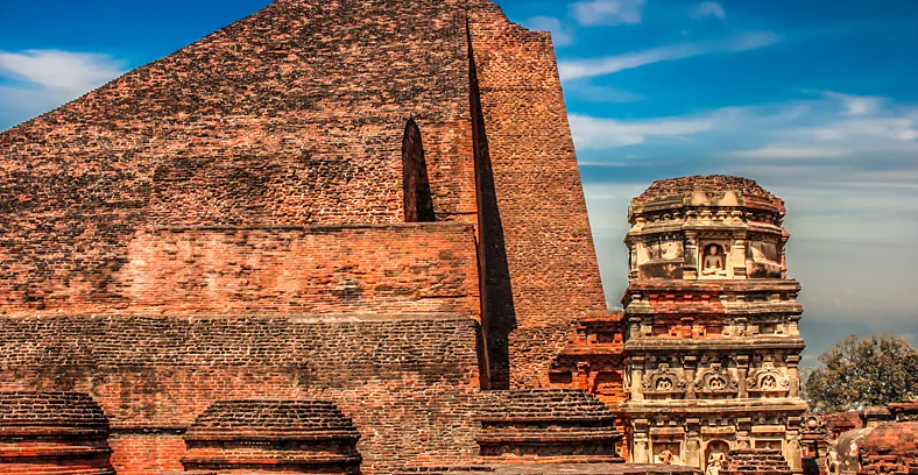Nalanda’s Historical Significance and Future Prospects (GS Paper 1, Art & Culture)

Context:
- Prime Minister Narendra Modi’s inauguration of the new Nalanda University campus at Rajgir brings renewed attention to Nalanda's historical legacy and aspirations for its future.
Historical Overview
Establishment and Patronage:
- Founded by Kumaragupta-I: Around 427 AD, Nalanda was established during the Gupta dynasty. It quickly became a renowned center of learning and spirituality.
- Support from Pala Kings: The university flourished under the patronage of the Pala kings, who ensured its growth and sustained its prominence. The monks at Nalanda received substantial support, particularly from the Pithipatis of Bodh Gaya.
Prominent Scholars and Contributions:
- Aryabhata: The famed mathematician and astronomer, known for his significant contributions to trigonometry and the concept of zero, was one of the prominent scholars associated with Nalanda.
- Harsha: An emperor and scholar, Harsha contributed to Nalanda’s legacy of interdisciplinary learning.
- Dharmapala and Nagarjuna: These Buddhist scholars played a pivotal role in the development of Buddhist philosophy and logic at Nalanda.
- Dharmakirti: Renowned for his works on Buddhist logic and epistemology.
- Hiuen Tsang’s Visit: The Chinese pilgrim and scholar Hiuen Tsang spent five years at Nalanda during the reign of Harshavardhan in the 7th century. His detailed accounts provide valuable insights into the rigorous academic life and administration at Nalanda.
International Influence:
- Nalanda's reputation attracted scholars from across Asia, including China, Japan, Korea, Tibet, and Southeast Asia.
- Sumatra’s Monastery: A king from Sumatra endowed a monastery at Nalanda, showcasing the university’s influence beyond India.
Controversies and Destruction
Bakhtiyar Khalji’s Raids:
- Historical Accounts: Historians like Satish Chandra and Habib recount the destruction brought by Bakhtiyar Khalji around 1200 AD, including the burning of Nalanda’s vast library.
- Conflicting Views: Some argue that Khalji's attacks targeted a different fort and not Nalanda itself. This perspective is based on interpretations of Minhaj-i-Siraj’s writings, suggesting Nalanda might have escaped the full extent of the Muslim conquests.
Decline of Buddhism:
- By the time of the Turko-Persian invasions, many Buddhist sites had been abandoned or converted to Brahminical temples. This contributed to Buddhism’s decline in India and Nalanda’s eventual obscurity.
- Rediscovery in the 19th Century: Nalanda was rediscovered during British colonial rule, reigniting interest in its historical significance and contributions to global knowledge.
Rediscovery and Revival
New Nalanda University Campus:
- Modern Reincarnation: The new campus at Rajgir aims to revive Nalanda’s legacy by creating a contemporary center for higher education and research, grounded in the ancient tradition of interdisciplinary learning.
- Global Academic Hub: The university aspires to attract scholars and students from around the world, fostering a spirit of intellectual exchange and collaboration.
Vision for the Future:
- Cultural Renaissance: The new Nalanda University seeks to become a beacon of knowledge, cultural exchange, and innovative research, much like its ancient predecessor.
- Educational Excellence: With state-of-the-art facilities and a curriculum that blends traditional wisdom with modern advancements, the university aims to contribute significantly to global education.
Conclusion
- Nalanda's rich history serves as a reminder of the resilience and enduring power of knowledge.
- The new university campus symbolizes a bridge between past and future, aiming to restore Nalanda’s historical prestige while adapting to contemporary educational needs.
- As we delve into Nalanda’s illustrious past, we recognize its potential to shape future generations.
- The renewed focus on Nalanda provides an opportunity to celebrate and build upon its legacy, ensuring that it once again becomes a vital center of learning and cultural exchange.
- As Oscar Wilde aptly put it, "The word is nothing; interpretation is everything." This holds true for Nalanda, where the interpretation of its past can guide its future towards renewed glory and academic excellence.


